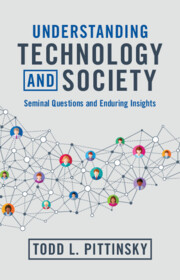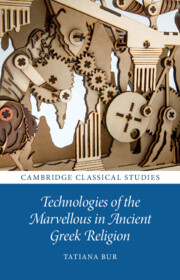Refine search
Actions for selected content:
933 results
7 - Technology, Nudges, Reputation, and Voluntary Compliance
-
- Book:
- Can the Public be Trusted?
- Published online:
- 11 October 2025
- Print publication:
- 30 October 2025, pp 165-185
-
- Chapter
-
- You have access
- Open access
- HTML
- Export citation
Chapter 20 - Bloomsbury and the Meanings of Labor
- from Part IV - Public Bloomsbury
-
-
- Book:
- A History of the Bloomsbury Group
- Published online:
- 09 October 2025
- Print publication:
- 23 October 2025, pp 334-348
-
- Chapter
- Export citation
5 - Naval Technology and the Geopolitics of the Kuroshio Highway
-
- Book:
- The Kuroshio Frontier
- Published online:
- 11 October 2025
- Print publication:
- 23 October 2025, pp 135-161
-
- Chapter
-
- You have access
- Open access
- HTML
- Export citation
6 - Knowledge, Technology Transfer and Convergence
-
- Book:
- An Economic History of Europe
- Published online:
- 02 October 2025
- Print publication:
- 02 October 2025, pp 132-154
-
- Chapter
- Export citation
4 - The Nature and Extent of Economic Growth in the Pre-industrial Epoch
-
- Book:
- An Economic History of Europe
- Published online:
- 02 October 2025
- Print publication:
- 02 October 2025, pp 85-107
-
- Chapter
- Export citation

Understanding Technology and Society
- Seminal Questions and Enduring Insights
-
- Published online:
- 30 September 2025
- Print publication:
- 10 July 2025
Chapter 10 - Media arts and meaning-making with children in S.P.A.C.E: A living inquiry storied through place and technology
-
-
- Book:
- The Arts and Meaning-Making with Children
- Published online:
- 11 September 2025
- Print publication:
- 25 September 2025, pp 212-236
-
- Chapter
- Export citation
3 - Exploitation
- from Part II - Working Environments: Extraction and the Making of Place
-
- Book:
- Burning Swamps
- Published online:
- 06 September 2025
- Print publication:
- 25 September 2025, pp 97-133
-
- Chapter
- Export citation
11 - “A Dead Child Is Better than a Missing One”
-
-
- Book:
- Reckoning with Law in Excess
- Published online:
- 09 September 2025
- Print publication:
- 25 September 2025, pp 258-294
-
- Chapter
-
- You have access
- Open access
- HTML
- Export citation
Practical issues in recruiting and retaining Asian American breast cancer survivors in a technology-based intervention study: A discussion paper
-
- Journal:
- Journal of Clinical and Translational Science / Volume 9 / Issue 1 / 2025
- Published online by Cambridge University Press:
- 11 September 2025, e198
-
- Article
-
- You have access
- Open access
- HTML
- Export citation
Chapter 10 - Science
- from Part II - Themes and Issues
-
-
- Book:
- The Cambridge Companion to Modernist Theatre
- Published online:
- 28 August 2025
- Print publication:
- 11 September 2025, pp 180-197
-
- Chapter
- Export citation

Technologies of the Marvellous in Ancient Greek Religion
-
- Published online:
- 04 September 2025
- Print publication:
- 24 July 2025
-
- Book
-
- You have access
- Open access
- Export citation
Chapter 33 - Technology
- from Part VIII - Ideas, Beliefs and Interventions
-
-
- Book:
- Schoenberg in Context
- Published online:
- 04 September 2025
- Print publication:
- 04 September 2025, pp 325-331
-
- Chapter
- Export citation
29 - Leading and managing in the digital age
- from Part 5 - Drives Innovation
-
-
- Book:
- Leading and Managing Health Services
- Published online:
- 15 August 2025
- Print publication:
- 28 August 2025, pp 330-342
-
- Chapter
- Export citation
Introduction
-
- Book:
- Railway Infrastructure and the Victorian Novel
- Published online:
- 12 August 2025
- Print publication:
- 28 August 2025, pp 1-23
-
- Chapter
- Export citation
28 - Healthcare quality and service improvement
- from Part 5 - Drives Innovation
-
-
- Book:
- Leading and Managing Health Services
- Published online:
- 15 August 2025
- Print publication:
- 28 August 2025, pp 316-329
-
- Chapter
- Export citation
22 - Negotiating
- from Part 4 - Achieves Outcomes
-
-
- Book:
- Leading and Managing Health Services
- Published online:
- 15 August 2025
- Print publication:
- 28 August 2025, pp 248-256
-
- Chapter
- Export citation
Introduction
-
- Book:
- AI versus IP
- Published online:
- 09 August 2025
- Print publication:
- 28 August 2025, pp 1-6
-
- Chapter
- Export citation
Spatial computing in design: opportunities and challenges of a new technological paradigm
-
- Journal:
- Proceedings of the Design Society / Volume 5 / August 2025
- Published online by Cambridge University Press:
- 27 August 2025, pp. 2901-2910
-
- Article
-
- You have access
- Open access
- HTML
- Export citation
Customer engagement, digitalization, and business performance: a model for digital startups
-
- Journal:
- Proceedings of the Design Society / Volume 5 / August 2025
- Published online by Cambridge University Press:
- 27 August 2025, pp. 1071-1080
-
- Article
-
- You have access
- Open access
- HTML
- Export citation
